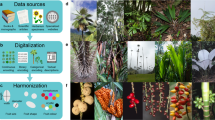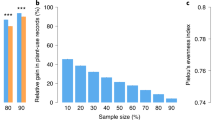Abstract
The well-being of the global human population rests on provisioning services delivered by 12% of the Earth's ∼400,000 plant species1. Plant utilization by humans is influenced by species traits2–4, but it is not well understood which traits underpin different human needs5. Here, we focus on palms (Arecaceae), one of the most economically important plant groups globally6, and demonstrate that provisioning services related to basic needs, such as food and medicine, show a strong link to fundamental functional and geographic traits. We integrate data from 2,201 interviews on plant utilization from three biomes in South America—spanning 68 communities, 43 ethnic groups and 2,221 plant uses—with a dataset of 4 traits (leaf length, stem volume, fruit volume, geographic range size) and a species-level phylogeny7. For all 208 palm species occurring in our study area, we test for relations between their traits and perceived value. We find that people preferentially use large, widespread species rather than small, narrow-ranged species, and that different traits are linked to different uses. Further, plant size and geographic range size are stronger predictors of ecosystem service realization for palm services related to basic human needs than less-basic needs (for example, ritual). These findings suggest that reliance on plant size and availability may have prevented our optimal realization of wild-plant services, since ecologically rare yet functionally important (for example, chemically) clades may have been overlooked. Beyond expanding our understanding of how local people use biodiversity in mega-diverse regions, our trait- and phylogeny-based approach helps to understand the processes that underpin ecosystem service realization, a necessary step to meet societal needs in a changing world with a growing human population5,8.
This is a preview of subscription content, access via your institution
Access options
Access Nature and 54 other Nature Portfolio journals
Get Nature+, our best-value online-access subscription
$29.99 / 30 days
cancel any time
Subscribe to this journal
Receive 12 digital issues and online access to articles
$119.00 per year
only $9.92 per issue
Buy this article
- Purchase on Springer Link
- Instant access to full article PDF
Prices may be subject to local taxes which are calculated during checkout



Similar content being viewed by others
References
The State of the World's Plants Report (Royal Botanic Gardens, Kew, 2016).
Díaz, S. et al. Functional traits, the phylogeny of function, and ecosystem service vulnerability. Ecol. Evol. 3, 2958–2975 (2013).
Diamond, J. Evolution, consequences and future of plant and animal domestication. Nature 418, 700–707 (2002).
Purugganan, M. D. & Fuller, D. Q. The nature of selection during plant domestication. Nature 457, 843–848 (2009).
Díaz, S. et al. Linking functional diversity and social actor strategies in a framework for interdisciplinary analysis of nature's benefits to society. Proc. Natl Acad. Sci. USA 108, 895–902 (2011).
Johnson, D. V. Tropical Palms (Food and Agriculture Organization of the United Nations, 2011).
Faurby, S., Eiserhardt, W. L., Baker, W. J. & Svenning, J. C. An all-evidence species-level supertree for the palms (Arecaceae). Mol. Phylogenet. Evol. 100, 57–69 (2016).
Kareiva, P., Watts, S., McDonald, R. & Boucher, T. Domesticated nature: shaping landscapes and ecosystems for human welfare. Science 316, 1866–1869 (2007).
Roosevelt, A. C., Da Costa, M. L., Machado, C. L. & Michab, M. Paleoindian cave dwellers in the Amazon: the peopling of the Americas. Science 272, 373 (1996).
Díaz, S., Fargione, J., Chapin, F. S. III & Tilman, D. Biodiversity loss threatens human well-being. PLoS Biol. 4, e277 (2006).
de Bello, F. et al. Towards an assessment of multiple ecosystem processes and services via functional traits. Biodivers. Conserv. 19, 2873–2893 (2010).
Kissling, W. D. et al. Quaternary and pre-Quaternary historical legacies in the global distribution of a major tropical plant lineage. Glob. Ecol. Biogeog. 21, 909–921 (2012).
Cámara-Leret, R., Paniagua-Zambrana, N. & Macía, M. J. in Proceedings of the Botany 2011 Symposium Honoring Richard E. Schultes (eds Ponman, B. & Bussmann, R. W. ) 41–71 (Missouri Botanical Garden, 2012).
Macía, M. J. et al. Palm uses in northwestern South America: a quantitative review. Bot. Rev. 77, 462–570 (2011).
Tardío, J. & Pardo-de-Santayana, M. Cultural importance indices: a comparative analysis based on the useful wild plants of southern Cantabria (northern Spain). Econ. Bot. 62, 24–39 (2008).
Westoby, M. A leaf–height–seed (LHS) plant ecology strategy scheme. Plant Soil 199, 213–227 (1998).
Forest, F. et al. Preserving the evolutionary potential of floras in biodiversity hotspots. Nature 445, 757–760 (2007).
Saslis-Lagoudakis, C. H. et al. Phylogenies reveal predictive power of traditional medicine in bioprospecting. Proc. Natl Acad. Sci. USA 109, 15835–15840 (2012).
Pagel, M. Inferring the historical patterns of biological evolution. Nature 401, 877–884 (1999).
Harvey, P. H. & Purvis, A. Comparative methods for explaining adaptations. Nature 351, 619–624 (1991).
Dransfield, J. et al. Genera Palmarum: The Evolution and Classification of Palms (Kew Publishing, 2008).
Martins, E. P. & Hansen, T. F. Phylogenies and the comparative method: a general approach to incorporating phylogenetic information into the analysis of interspecific data. Am. Nat. 149, 646–667 (1997).
Díaz, S. et al. The global spectrum of plant form and function. Nature 529, 167–171 (2016).
Cámara-Leret, R., Paniagua-Zambrana, N., Svenning, J.-C., Balslev, H. & Macía, M. J. Geospatial patterns in traditional knowledge serve in assessing intellectual property rights and benefit-sharing in northwest South America. J. Ethnopharmacol. 158, 58–65 (2014).
Maslow, A. H. A theory of human motivation. Psychol. Rev. 50, 370 (1943).
Gruca, M., Cámara-Leret, R., Macía, M. J. & Balslev, H. New categories for traditional medicine in the economic botany data collection standard. J. Ethnopharmacol. 155, 1388–1392 (2014).
Soberón, J. & Peterson, A. T. Biodiversity governance: a tower of Babel of scales and cultures. PLoS Biol. 13, e1002108 (2015).
Cámara-Leret, R., Paniagua-Zambrana, N., Balslev, H. & Macía, M. J. Ethnobotanical knowledge is vastly under-documented in northwestern South America. PLoS ONE 9, e85794 (2014).
Meyer, R. S., DuVal, A. E. & Jensen, H. R. Patterns and processes in crop domestication: an historical review and quantitative analysis of 203 global food crops. New Phytol. 196, 29–48 (2012).
Nicotra, A. B. et al. Plant phenotypic plasticity in a changing climate. Trends Plant Sci. 15, 684–692 (2010).
Henderson, A. Evolution and Ecology of Palms (The New York Botanical Garden Press, 2002).
Henderson, A. A multivariate analysis of Hyospathe (Palmae). Am. J. Bot. 91, 953–965 (2004).
Henderson, A. A multivariate study of Calyptrogyne (Palmae). Syst. Bot. 30, 60–83 (2005).
Henderson, A. A revision of Geonoma (Arecaceae). Phytotaxa 17, 1–271 (2011).
Henderson, A. A revision of Desmoncus (Arecaceae). Phytotaxa 35, 1–88 (2011).
Henderson, A. A revision of Pholidostachys (Arecaceae). Phytotaxa 43, 1–48 (2012).
Henderson, A. & Villalba, I. A revision of Welfia (Arecaceae). Phytotaxa 119, 33–44 (2013).
Galeano, G. & Bernal, R. Palmas de Colombia: Guía de Campo (Editorial Universidad Nacional de Colombia, 2010).
Sanín, M. J. & Galeano, G. A revision of the Andean wax palms, Ceroxylon (Arecaceae). Phytotaxa 34, 1–64 (2011).
Göldel, B., Kissling, W. D. & Svenning, J. C. Geographical variation and environmental correlates of functional trait distributions in palms (Arecaceae) across the New World. Bot. J. Linn. Soc. 179, 602–617 (2015).
Balslev, H., Macía, M. J. & Navarrete, H. Cosecha de Palmas en el Noroeste de Suramérica: Bases Científicas Para Su Manejo y Conservación (Pontificia Universidad Católica del Ecuador, 2015).
The Plant List (Royal Botanical Garden, Kew & Missouri Botanical Garden); http://www.theplantlist.org
Bjorholm, S., Svenning, J.-C., Skov, F. & Balslev, H. Environmental and spatial controls of palm (Arecaceae) species richness across the Americas. Glob. Ecol. Biogeogr. 14, 423–429 (2005).
Henderson, A., Galeano, G. & Bernal, R. Field Guide to the Palms of the Americas (Princeton Univ. Press, 1995).
Borchsenius, F. & Bernal, R. Aiphanes (Palmae) (New York Botanical Garden Press on behalf of Organization for Flora Neotropica, 1996).
Kahn, F. The genus Astrocaryum (Arecaceae). Rev. Peru. Biol. 15, 31–48 (2008).
Kahn, F., Millán, B., Pintaud, J.-C. & Machahua, M. Detailed assessment of the distribution of Astrocaryum sect. Huicungo (Arecaceae) in Peru. Rev. Peru. Biol. 18, 279–282 (2011).
Henderson, A. Bactris (Palmae) (New York Botanical Garden Press on behalf of Organization for Flora Neotropica, 2000).
Paniagua-Zambrana, N., Macía, M. J. & Cámara-Leret, R. Toma de datos etnobotánicos de palmeras y variables socioeconómicas en comunidades rurales. Ecol. Bolivia 45, 44–68 (2010).
Borchsenius, F., Pedersen, H. B. & Balslev, H. Manual to the Palms of Ecuador (Aarhus Univ. Press, 1998).
Moraes, M. Flora de palmeras de Bolivia (Plural Editores, 2004).
Thiers, B. Index Herbariorum: A Global Directory of Public Herbaria and Associated Staff. New York Botanical Garden's Virtual Herbarium (New York Botanical Garden, 2016); http://sweetgum.nybg.org/ih/
Cook, F. Economic Botany Data Collection Standard. Prepared for the International Working Group on Taxonomic Databases for Plant Sciences (TDWG) (Royal Botanic Gardens Kew, 1995).
Cámara-Leret, R. et al. Ecological community traits and traditional knowledge shape palm ecosystem services in northwestern South America. Forest Ecol. Manag. 334, 28–42 (2014).
R Core Team. R: A Language and Environment for Statistical Computing (R Foundation for Statistical Computing, 2015).
Ho, L. S. T. & Ané, C. phylolm: Phylogenetic Linear Regression. R package v.2.5 (2015); https://cran.r-project.org/package=phylolm
Revell, L. J. Phytools: an R package for phylogenetic comparative biology (and other things). Methods Ecol. Evol. 3, 217–223 (2012).
Paradis, E., Claude, J. & Strimmer, K. APE: analyses of phylogenetics and evolution in R language. Bioinformatics 20, 289–290 (2004).
Spiess, A. & Ritz, C. qpcR: Modelling and analysis of real-time PCR data (R Foundation for Statistical Computing, 2014).
Acknowledgements
We thank the 68 study communities and participants of our fieldwork interviews. We are also grateful to our partner institutions and their research teams who dedicated resources to facilitate our research. We thank G. Galeano, R. Bernal, J.-C. Pintaud, R. Valencia, H. Navarrete, L. de La Torre, M. Moraes, B. Millán and R. Carrillo for their support and discussions. We extend our gratitude to J.C. Copete, M. Soto Gomez, N. Paniagua, L. Camelo, R. Bussmann and M. Jaimes for assistance in fieldwork, to D. Warren for helpful discussions, to S. Cámara-Leret for contributing palm illustrations, and to I. Cámara-Leret for assistance with design and layout of figures. This study was funded by the European Union, 7th Framework Programme (FP7-PALMS-Contract no. 212631, to H.B.), and also supported by the Russell E. Train Education for Nature Program of the WWF, Anne S. Chatham Fellowship of the Garden Club of America, William L. Brown Center, Universidad Autónoma de Madrid travel grants programme, and a GSST fellowship of Aarhus University. J.-C.S. and B.G. were supported by the European Research Council (ERC-2012-StG-310886-HISTFUNC); C.H.S.-L. and N.R. by the People Programme (Marie Curie Actions) of the European Union's 7th Framework programme (FP7-PEOPLE-2012-IEF-328637 - BiodiversityAltitude); W.D.K. by the Netherlands Organization for Scientific Research (824.15.007) and the University of Amsterdam (starting grant); and H.B. by the Danish National Science Research Council (272-06-0476).
Author information
Authors and Affiliations
Contributions
R.C.-L. and C.H.S.-L. conceived and designed the study. R.C.-L. and M.J.M. did the ethnobotanical fieldwork. R.C.-L., M.J.M., H.B., S.F., B.G. and W.D.K. provided data. R.C.-L., B.G. and H.B. built new geographic range maps. R.C.-L., C.H.S.-L. and S.F. analysed the data. R.C.-L. and C.H.S.-L. wrote the paper. All authors discussed the results and commented on the manuscript.
Corresponding author
Ethics declarations
Competing interests
The authors declare no competing financial interests.
Supplementary information
Supplementary Information
Supplementary Figures 1–3, Supplementary Tables 1–4. (PDF 1954 kb)
Rights and permissions
About this article
Cite this article
Cámara-Leret, R., Faurby, S., Macía, M. et al. Fundamental species traits explain provisioning services of tropical American palms. Nature Plants 3, 16220 (2017). https://doi.org/10.1038/nplants.2016.220
Received:
Accepted:
Published:
DOI: https://doi.org/10.1038/nplants.2016.220
This article is cited by
-
Functional Traits Drive the Selection of Plant Species Used by Agropastoralists in the Brazilian Semiarid Region
Economic Botany (2024)
-
A plastid phylogenomic framework for the palm family (Arecaceae)
BMC Biology (2023)
-
Human activities and species biological traits drive the long-term persistence of old trees in human-dominated landscapes
Nature Plants (2023)
-
Usage Patterns and Conservation Practices of Wild Palm Species (Arecaceae) in Western Burkina Faso
Economic Botany (2023)
-
Complete chloroplast genomes of six neotropical palm species, structural comparison, and evolutionary dynamic patterns
Scientific Reports (2023)



